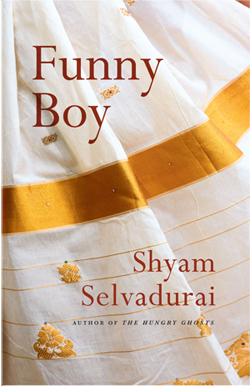Funny Boy @ 25: How the story finally found its voice

Shyam Selvadurai
Funny Boy is a cult and more. It comes with the conspiratorial whisper “Just be yourself- however hostile the world may be”.
Winner of the Canada First Novel Award and the Lambda Award, the book has been translated into more than eight languages, and turned into a film, still to be released.
As Funny Boy celebrates its 25th anniversary, author Shyam Selvadurai in an email interview with the Sunday Times looks at how the novel came to be. (Some extracts have been drawn from a text written for the special anniversary edition by the author).
It was the fall of 1990, and Shyam Selvadurai had broken free of the gray, utilitarian routine of Scarborough, Toronto, to go live in Montreal- the “city of festivals”- a vibrant, colourful explosion in glorious, russet autumn where, away from his parents’ house for the first time- he began writing a novel.
He had been inspired by Anita Desai’s novel Clear Light of Day, where the Indian Partition of 1947 whips up a miniature storm within an English speaking upper middle class family in Delhi. He had never before seen his own childhood milieu in Colombo so closely matched in literature (give or take the bigger cacophony of the 20th Century Delhi).

Funny Boy: The 25th anniversary edition
The book threw open a back door in his mind, and he knew he too had a story to tell. Desai’s Partition could be replaced by Sri Lanka’s Sinhala- Tamil ethnic riots- which forced the Selvadurais to seek refuge in Canada in 1983.
Like Desai, he would write about “not those who made history, but those who were swept along by it”.
That first year of writing in Montreal was heady and golden. Shyam would go for long walks, inhale the freedom of that ‘raucously lit’ city and write – his writing stamina growing the more he wrote. There was the “excitement of seeing (himself) slowly gaining mastery over scene, dialogue, and language”.
In a year, the novel was done- a story of the riots pretty much following Desai’s structure.
The afterglow of it radiated in him for some weeks but soon, reading with detachment, something ‘bewildering, scary’ suddenly crashed on him. He realized the novel was really a failure- a ‘stillborn’- that he could not re-enter.
It was shattering as he had only saved money for a year in Montreal- and it was over.
With no cards left to play Shyam began working at a video store. One evening, “to fill the awful hours and tire myself out”, he set himself the task of writing a page of first person narrative.
Soon he was writing about a boy watching his mother wearing a sari. A chance memory tossed up- he knew that the boy was himself, and wanted to drape the sari himself. It was a powerful moment and the story would then unfold- from his own youth- of a boy who loved to dress up as a bride. The story had finally found its voice.
The first story in the novel- Pigs Can’t Fly- ends after Arjie runs crying from the hostile world that would not let him be what he wants to be. But Shyam knew he had to follow an older Arjie again- with his compelling voice. He wrote four more stories and an epilogue – which would make up the novel.
Though based on Shyam’s childhood, Arjie’s world could not have been more different. Tempest-tossed between awakening homosexuality and rumbling ethnic troubles, the novel was like a wild monsoon beach with the bittersweet pangs of adolescence. In reality Shyam grew up in a happy domestic world amidst a loving, understanding family. Till, of course, the very real ethnic tensions erupted. The novel had to have many conflicts as happy endings would not have provided impetus and tension- and would not have allowed Arjie to ‘grow wise’.
Early on, Shyam had an imagined reader for Funny Boy: “a young Sri Lankan person, who would pick up the novel and find in it their own queerness…and know, by reading about Arjie’s journey, that they were not alone, that resistance and happiness were possible.”
Once the monsoonal sweep of the novel came to its end, Shyam would have been happy had the novel been taken “by a small press- if that”.
Shyam hadn’t dreamt of the success to come- probably eclipsing Desai’s novel, or Alice Munro’s Lives of Girls and Women which first gave him the idea of a novel in six stories.
The rest of course is history- but it remains to be known precisely how that storm of praise and awards floored Shyam, taking him totally unawares, months later.
“I suspect that perhaps part of the lasting value lies in the authenticity of its voice,” he says. He did not “talk down to, or even talk at, the reader, but rather invited them into a world (he) knew and loved and lost”.
The charismatic presence of Arjie himself- slightly feminine and silent but spirited, defiant, rebellious and imaginative throughout- was another.
Shyam adds finally:
“The novel also tells another universal story: that of a people whose daily lives are thrown into turmoil when the negative forces in their society prevail—be it the Holocaust, Rwanda, Iran of the last 1970’s or Syria of today. It tells a very Canadian story too—about the lives and circumstances of the thousands of people we take into our land as refugees, who walk the streets of our cities. It tells of the circumstances that drove them to leave their home and seek a new one here in Canada.”



